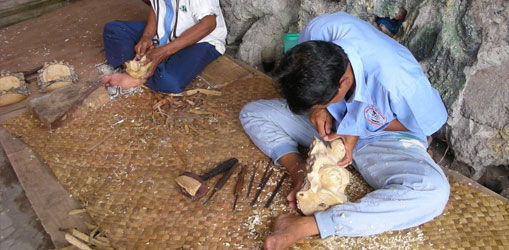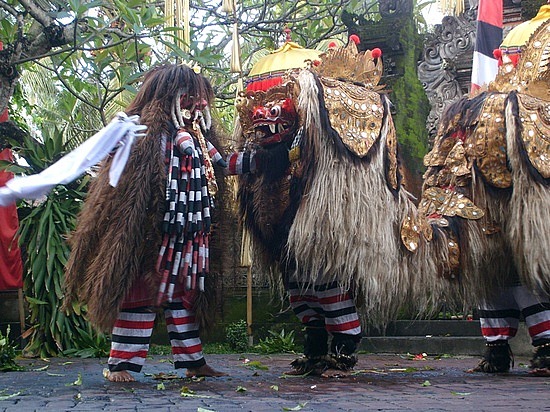The Mas Village lies on the main road, 20 km to the north of Denpasar and 6 km before Ubud, in a hilly countryside covered with rice-fields and irrigated year-round by the waters of the Batuan aud Sakah rivers. Today the Mas Village appears as a succession of palatial art shops, as Mas has developed into a flourishing center for the woodcarving craft. Indeed, it is difficult to imagine what the village was like before dozens of tourist buses started to drop in everyday yet Mas actually played an important role in Balinese history during the 16th century, as it was the place where a great priest from Java, Danghyang Nirartha (also called Dwijendra), had his hermitage (Griya).
During the 1930s, under the influence of Walter Spies and Pita Maha, a new style of woodcarving developed here. The motifs were more realistic, and inspired by everyday scenes featuring humans and animals. Several of these early works may now be seen in Ubud’s Puri Lukisan museum. During this period, woodcarvings began to be appreciated and purchased by foreigners, but only after 1970 did the real boom take place. The first art shops in Mas were those of Ketut Roja (Siadja & Son), followed by Ida Bagus Nyana and his son Ida Bagus Tilem, and Ida Bagus Taman (Adil Artshop). At first they all produced works of quality in limited quantities, mainly working with locally-available woods.
How to get to Mas Village :
1. 45 minutes from Sanur
2. 60 minutes from Kuta
3. 10 minutes from Ubud
What you can see Mas Village :
1. Rudana Museum was established in 1995, with the main aim of providing an outstanding collection of paintings for the public to study and enjoy. Its presence must also be considered as complementing the existing total of fine art museums, which are much needed in order to improve the community’s level in the appreciation of the arts.
2. Goa Gajah (Elephant Cave) located two kilometers east of Ubud , this complex overlooks the Petanu river and consists of a SiSwati rock-cut cave, a bathing place, a monks’ chamber, a number of Buddhists rock cut Stupa and statues , and several foundations.
3. Yeh Pulu, the relief is carved on rock, located near Goa Gajah, between rice field and ravine. The site was rediscovered in 1925. In 1949 a simple protection was laid out to avoid water flowing on the surface of the relief. It looks like panel with the size of 25 x 2 meters.
4. Ubud Monkey Forest, the monkeys within the Sacred Monkey Forest of Padangtegal are commonly called long-tailed macaques. Their scientific name is Macaque fascicular. Macaques are found throughout Southeast Asia and many species of macaques live successfully in areas that are heavily utilized by humans.






